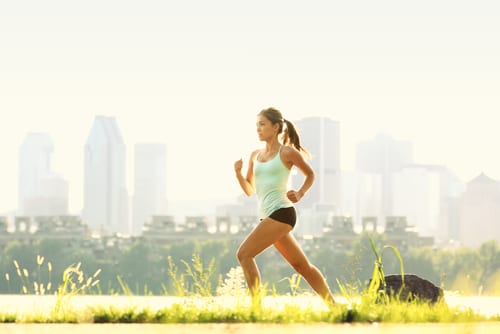As the heat wave continues despite the calendar saying it’s fall, the reality is that exercising in the heat will be with us for the foreseeable future. However, exercising in higher temperatures should be approached with some caution and planning.
It is well known that the added thermal load of the heat increases the stress on the heart, especially during activity. As the heart works to provide blood and oxygen to the exercising muscles, it must also shunt blood the skin where it can be cooled by the evaporation of our sweat. In addition, for every degree the body’s internal temperature rises the heart beats approximately 10 bpm faster. Exercise plus higher body temperatures and the added work of shunting blood for cooling can dramatically increase the stress on the heart during an exercise session in hotter temperatures. This is especially worse with higher humidity when the body has more difficulty with evaporative cooling.
When exercising in the heat, it is wisest to exercise in the cooler morning or evening hours to minimize the thermal stress. On hot, humid days it is best to slow your normal exercise duration and/or pace as well. Monitoring of your exercise heart rate and staying within the ranges prescribed by your exercise physiologist or rehabilitation staff will help you adjust your exercise level for the added thermal load and avoid overworking your heart. As a rule of thumb, if the temperature is above 80° F and the humidity above 80%, it’s best to postpone outside activity until things cool off.
I often do my garage workouts after clinic and despite aggressive hydration and using fans to help cooling, some days are absolutely unbearable! I’ve found that high intensity interval training (HIIT – short bursts of high intensity exercises) with frequent fluid breaks can be the best approach on those days. Swimming (my personal favorite) and aquatic exercise are a great way to exercise and keep cool during activity on warmer weather, higher humidity days. Alternatively, bring the exercise indoors.
If your session will be longer than 30 minutes, fluid maintenance becomes very important. Drink 8–12 oz. of water 20–30 minutes prior to exercise plus 6–10 oz. additional every 20-30 minutes of exercise to help prevent dehydration. For most individuals, water is an acceptable fluid replacement. Unless your exercise sessions exceed an hour and your fluid and electrolyte loss is extensive and chronic, sports drinks tend to add unnecessary sodium and calories.
Lastly, dress for the temperature and the activity. Rubber sweat suits that prevent evaporation of sweat interfere with the body’s ability to cool itself and can raise body temperatures to dangerously high levels. Wear loose fitting cotton or wicking-type t-shirts, shorts and a brimmed hat when exercising outside in the summer. And don’t forget your sunscreen.
Yours in health,
Eduardo R. Elizondo, MD, CLCP
Fellow, American College of Sports Medicine




